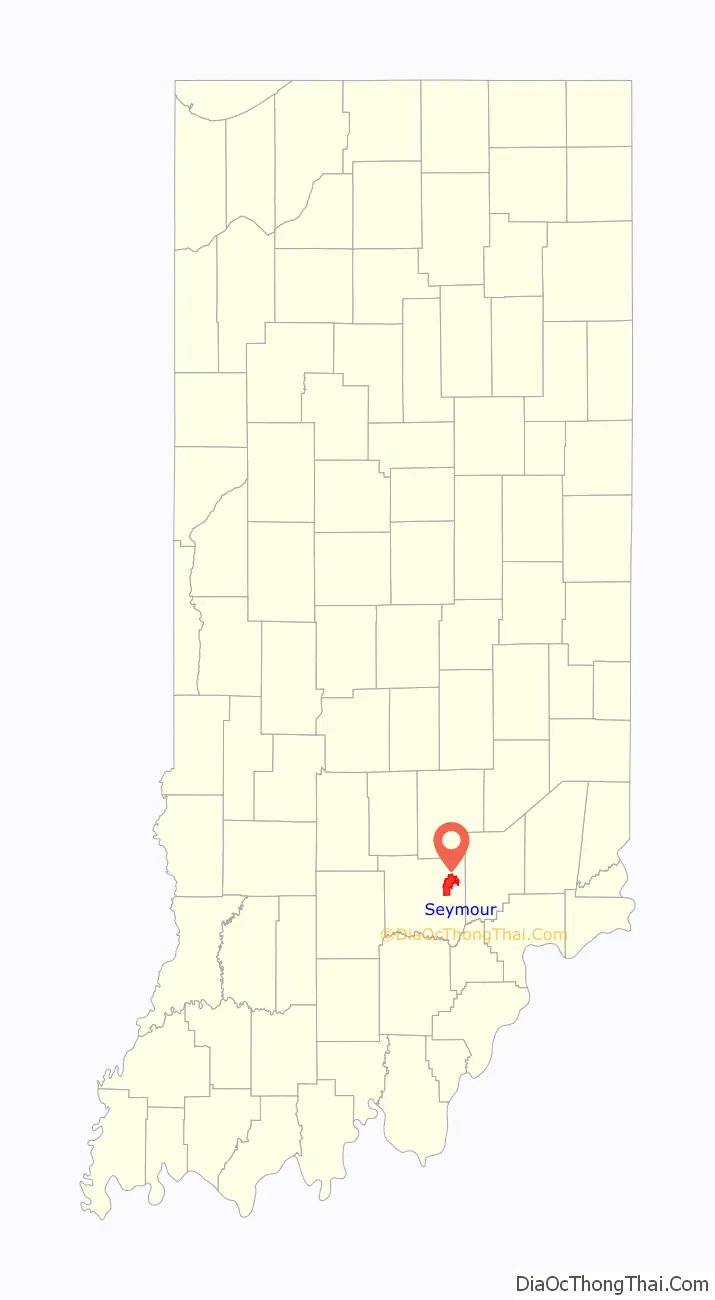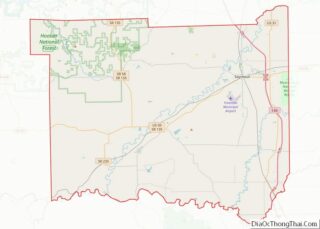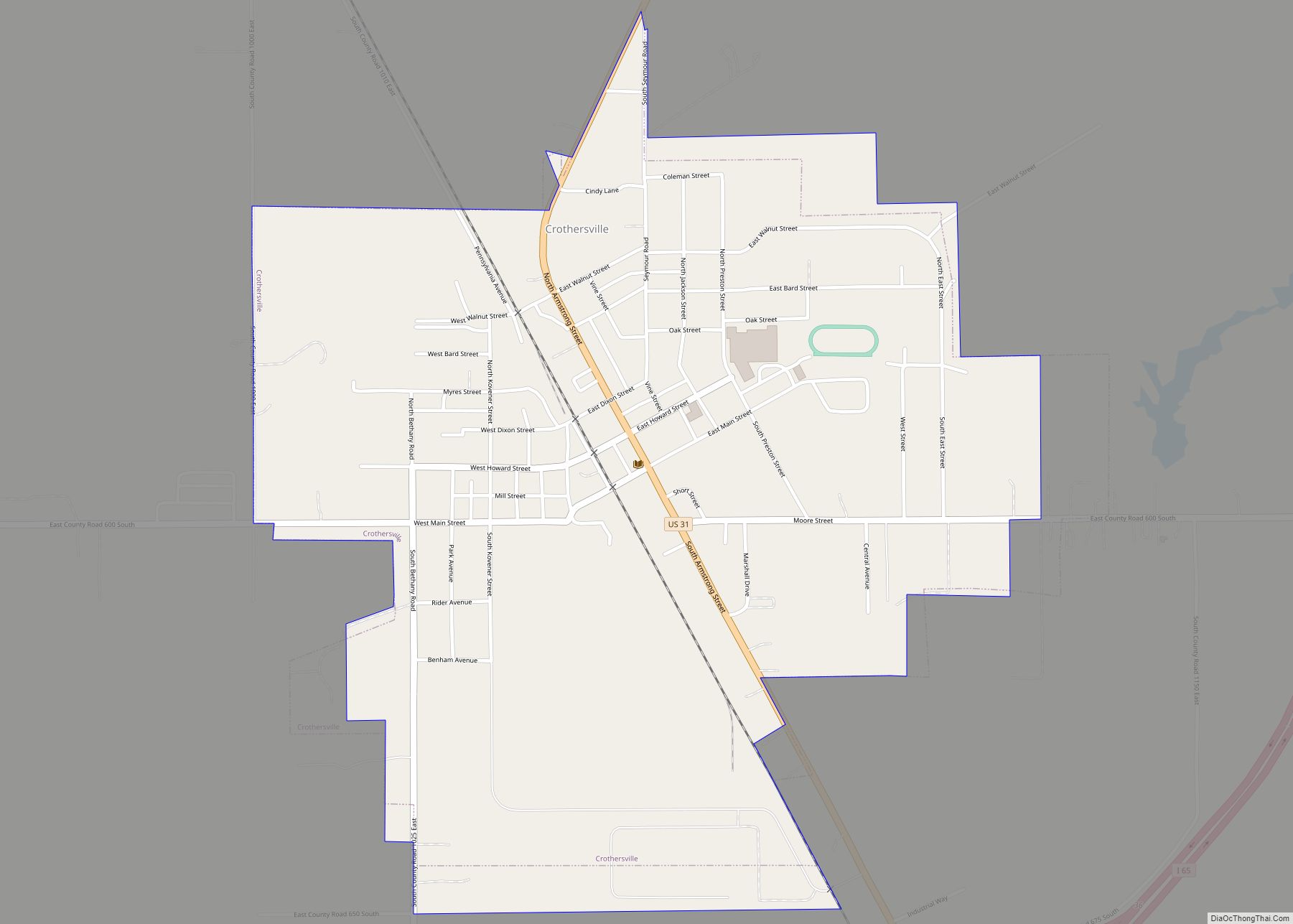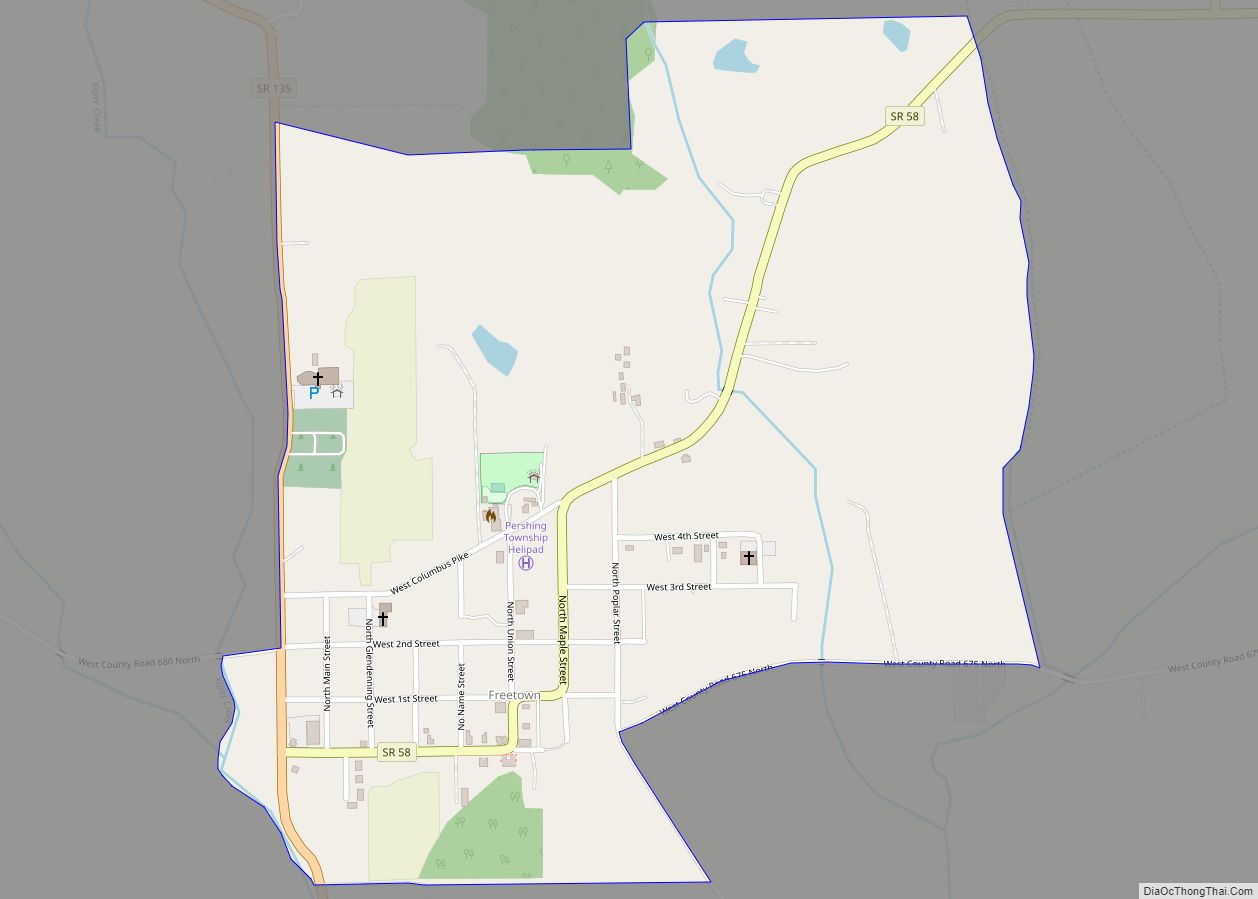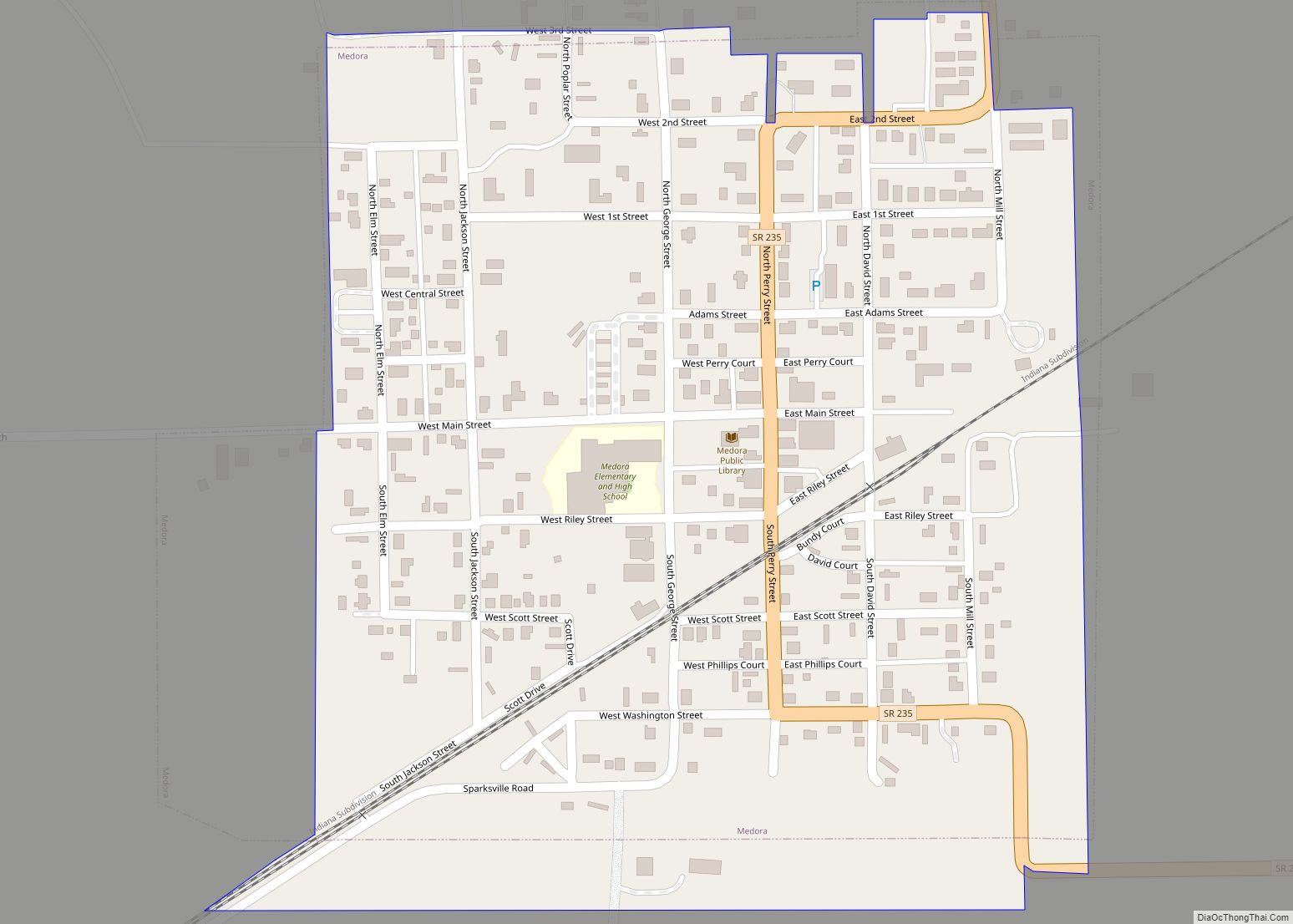Seymour is a city in Jackson County, Indiana, United States. Its population was 21,569 at the 2020 census.
The city is noted for its location at the intersection of two major north–south and east–west railroads, which cross each other in the downtown area. The north–south line (the Jeffersonville, Madison and Indianapolis Railroad) was built in the 1840s and connected Indianapolis to the Ohio River at Jeffersonville. In 1852, Captain Meedy Shields persuaded Hezekiah Cook Seymour into building the east-west railroad (the Ohio and Mississippi Railroad) through his land, and in return named the city in Seymour’s honor. The first settlers arrived in the spring of 1853.
The companies Aisin USA and Rose Acre Farms are headquartered in Seymour, and Cummins operates a plant in the area. The city is also home to the 2nd largest high school gymnasium in the United States by seating capacity.
| Name: | Seymour city |
|---|---|
| LSAD Code: | 25 |
| LSAD Description: | city (suffix) |
| State: | Indiana |
| County: | Jackson County |
| Elevation: | 602.91 ft (183.77 m) |
| Land Area: | 11.42 sq mi (31.42 km²) |
| Water Area: | 0.005 sq mi (0.01 km²) |
| Population Density: | 1,777.86/sq mi (686.41/km²) |
| Area code: | 812 & 930 |
| FIPS code: | 1868832 |
| GNISfeature ID: | 0443233 |
| Website: | www.seymourin.org |
Online Interactive Map
Click on ![]() to view map in "full screen" mode.
to view map in "full screen" mode.
Seymour location map. Where is Seymour city?
History
19th Century
Seymour was laid out and plated on April 27, 1852, near the 1809 Indian Treaty Corner and approximately two miles south of the village of Rockford, Indiana; the terminus of the north-south railroad before the opening of the purchase of 1828 and the construction of the railbridge over the White River. During the latter 1840’s, a north–south railroad connecting the Ohio River at Jeffersonville with Indianapolis was built crossing the Shields’ farm. In 1852, an east–west railroad was being surveyed through Jackson County and Meedy Shields persuaded the Ohio and Mississippi Rail Road to run through his property. In exchange for this favor, he agreed to name the town after the railroad’s civil engineer, Henry C. Seymour, although some sources mention J. Seymour, who was the surveyor.
Seymour was derisively referred to as a “mule crossing” because its slow initial development and lack of interest from the railroad companies. The town did not see significant development until the state legislature, led by the efforts of local landowner and Indiana State Senator Meedy Shields, passed a law requiring all trains to stop at railroad-railroad intersections. By increasing safety statewide in a time before widespread semaphore use, it increased the value of land around such intersections and made them safer for warehousing.
In 1858, Blish Mill opened as the first mill in town. By 1881, Seymour would have three mills within the city limits. The large grain tower still stands near the north-south and east-west railroad intersection and the center of town.
Seymour was once a stop on the Underground Railroad. On April 20, 1860, an Adams Express package shipped from Nashville, Tennessee, and addressed to “Hannah Johnson [care of] Levi Coffin” burst open at Seymour while en route to Cincinnati, Ohio. Levi Coffin was a leading Hoosier abolitionist and the unofficial leader of the Underground Railroad. The package contained a person fleeing slavery and looking for freedom in the north. A similar incident occurred earlier in Kentucky. The true identity of “Hannah Johnson” remains a mystery. Although Indiana was a “free state”, Article XIII of the state constitution of 1851 made it illegal for African Americans to settle in Indiana and the Fugitive Slave Act permitted bounty hunters to capture and return people to slavery. The fugitive, later identified as Alexander McClure, was arrested and returned to Louisville and then to his owner in Nashville, Tennessee.
During the American Civil War, despite southern Indiana’s strong Copperheads political sentiment, the city of Seymour and the surrounding area raised three separate infantry regiments for service in the Union Army. Volunteers from Seymour were organized at Camp Heffron in Seymour. The entirety of the 50th Indiana Infantry Regiment commanded by former Indiana Secretary of State, Colonel Cyrus L. Dunham, portions of the 6th Indiana Infantry Regiment and 10th Indiana Cavalry Regiment. In 1863, Captain Meedy Shields trained local minutemen militia units in response to Morgan’s Raid while several regiments of infantry were sent from the state capitol in Indianapolis.
Due to its strategic location along rail lines with the large cities of Indianapolis, Chicago, and Detroit to the north and St. Louis to the west, Seymour was an important waypoint for the movement of men and supplies to the front during the war. On January 20, 1864, during the transfer of Confederate prisoners of war, six officers escaped. One was later recaptured in town. The New York Times reports that on January 22, 1864, a “Soldier’s riot” took place, wherein two soldiers were killed and several others were injured.
The 50th Indiana Infantry Regiment lost during their service 3 officers and 54 enlisted men killed and mortally wounded and 3 officers and 158 enlisted men by disease for a total of 218 casualties during the war. Colonel Dunham, a Democrat, was accused of harboring Confederate sympathies and mustered out of the regiment in 1863 under a cloud of suspicion. Lt. Colonel Heffron, who was poorly regarded by the men of the regiment, was also dismissed from the army and replaced by Major Samuel T Wells, a Valonia, Indiana, native, Mexican-American war veteran, and former Jackson County Sheriff. Wells would go on to command the regiment after Durham’s resignation until the 50th was dissolved and all men transferred to the 52nd Indiana Infantry Regiment who were also stationed in Mobile, Alabama until the War’s end.
After the war, local veterans organized the Ellsworth Post 20 of the G.A.R. At its zenith, the post included two hundred and twenty-two local citizens who had served the Union during the war as members. During its long existence, the organization included many prominent community members. The Ellsworth Post was active in local charities, organized burial services for local veterans, and conducted official observances on Decoration Day. The final member of the post, James H Boak, lived to be 98 years old. He died in 1942 closing one of the longest-running G. A. R. chapters in existence.
An infamous local murder occurred in January 1866, when a traveling merchant, Moore Woodmansee, 42, on his way to Cincinnati, Ohio, disappeared while staying at the Rader House. The Rader House was operated by proprietor Captain George Rader, a purported Reno Associate, and was the center of gambling, theft, prostitution, and a string of mysterious disappearances. Months after he disappeared, the headless body of Woodmansee was found downriver in the East Fork of the White River; then known as the Driftwood River. Rader was implicated in the murder. Two local witnesses were murdered. Rader and his son-in-law were ultimately acquitted but forced to leave town.
A robbery of the Adams Express Car on the east-west Ohio and Mississippi line near Brownstown was reported in July 1866. That night, the perpetrators were chased by a local vigilance committee of 300 men that continued into the Rockford area. Three days later, the Reno brothers had been identified as the gang’s leaders and newspapers were recounting the notorious deeds of the family. Later that year, Seymour was the site of the world’s first successful peacetime train robbery, in which the train was moving. It was committed by the local Reno Gang, on October 6, 1866, just east of town, starting in the Adams Express Company car of the Ohio and Mississippi Railroad. The gang was put in prison for the robbery and later lynched at Hangman’s Crossing outside town. The insolvent Ohio and Mississippi Railroad was reorganized in 1867 as the Ohio and Mississippi Railway.
About 1876, a general strike of approximately 500 railroad men occurred at Seymour and nearby North Vernon, Indiana, led by armed brakemen, engineers, and other railroad employees who had not been paid for two and a half months by the Ohio and Mississippi Railroad. A paper reported that the communities of Seymour and North Vernon were armed and in revolt. A contingent of US Marshals and detectives was sent from Cincinnati to end the strike. All passenger and cargo service through Seymour and North Vernon was suspended during the strike. The Ohio and Mississippi Railway was purchased in 1893 by B&O Southwestern Railroad.
The town’s first high school was built in 1871 on the vacant lot of the disbanded civil war encampment. Frank B Shields, a Seymour native, former MIT professor, and inventor of Barbasol shaving cream subsequently donated the adjacent land needed for the construction of the James Shields memorial gym.
During the years prior to the turn of the 20th century, Seymour saw a significant influx of Dutch and German migrants of the Lutheran faith. These migrants eventually established many successful local farms and businesses. These pioneers’ influence continues today and can be seen in the city’s annual Oktoberfest celebration.
20th Century
Seymour fielded its own minor league team, the Seymour Reds, beginning in 1900. Pee Wee Reese once played with the Seymour Reds before being called up to the majors. The team had their own field, Redlands Park, north of Shields City Park.
The Seymour Public Library opened to the public in January 1905, following a grant of $10,000 from the Carnegie Foundation in 1903 led by the Public-School Superintendent and President of the Seymour Public Library Board, Professor H.C. Montgomery. Efforts to bring a library to Seymour began twenty years early in 1881. Early library collections were housed in a local bookshop and then at Shields High School until the new Carnegie Library opened. The public library was part of more than $2.6 million in grants issued in the state of Indiana for more than 160 libraries: more than any other state.
During World War I, nine Seymour natives died in combat. Seymour’s first municipal airport, the White River Valley Flying Field, was located on the Henry Ahlert farm (once owned by the Renos) near the White River north of the city.
In 1934, Seymour police officer John Pfaffenberger was shot and killed by three assailants after he attempted to stop their car after they stole a few dollars worth of fuel from a gas station east of town. One defendant, Nashville, Indiana, native Edward Coffin, was subsequently sentenced to death and sent to Indiana’s electric chair for the murder of Officer Pfaffenberger. His co-defendants were sentenced to lengthy prison sentences.
During World War II, the US government purchased 2,500 acres of land southwest of town for use as an airfield. Freeman Army Airfield operated from 1942 to 1946. The base was first used for twin-engine training. The first class graduated on 29 April and went on to fly multi-engine aircraft such as the B-24 Liberator, B-17 Flying Fortress, B-29 Superfortress, and various other medium bombers and transport aircraft. Twin-engine training continued with a total of 19 classes of students graduating from Freeman Field using a total of 250 Beechcraft AT-10 Wichita trainers. The last graduates were in May 1944; 4,245 total cadets.
Freeman Army Airfield was the first helicopter base in the US. The first instructor pilots arrived on 30 June and preparations for the helicopter training were made in great secrecy, as in 1944 very few people had seen one and the technology was new and revolutionary. The group assigned to coordinate their arrival was known as “Section B-O”. A total of six Sikorsky R-4 helicopters were assigned for training, flown directly to Freeman from the Sikorsky plant at Bridgeport, Connecticut. This was the longest-distance flight of any formation of helicopters at the time.
The Freeman Field Mutiny occurred in 1945, in which African American members of the 477th Bombardment Group attempted to integrate an all-white officers’ club at Freeman Army Air Corps Base. The mutiny later led to the integration of the United States military.
Nearing the end of WWII, Freeman Field was designated the Foreign Aircraft Evaluation Center for the Air Force. After the end of the war in Europe, captured German and Italian aircraft were collected by “Operation Lusty”. Freeman Field was also charged with the mission to receive and catalog United States equipment for display at the present and for the future AAF museum. However, these operations, including the helicopter training missions were moved to other locations, and Freeman Field was deactivated and deeded to the city of Seymour in 1946. Future astronaut Gus Grissom enlisted as an aviation training cadet at Freeman Field in 1944.
During the last week of June 1952, the city of Seymour held a week-long centennial celebration that included concerts, parades, a re-enactment of the Reno Brothers train robbery, contests, and a play entitled “The Seymour Story”. The B&O Railroad loaned Engine #25 and several cars from their Baltimore Museum for use in the Reno reenactment scenes. During the week, local industries paid their employers in silver dollars to commemorate the event.
During the Korean War, five soldiers from Seymour died in the conflict.
Beginning in 1959, the city’s former high school, Shields High School, was moved to the new Seymour High School west of town. In 1970, the school corporation completed the construction of the second-largest school gymnasium in the United States. In 1981, the gym was renamed the “Lloyd E Scott” gymnasium in honor of the Indiana Hall of Fame basketball coach.
Seymour police officer Donald M. Winn was severely wounded investigating an attempted burglary on October 28, 1961. He died of the wounds on November 7, 1961. Winn was a veteran of WWII, the son of a state police officer, and the former Chief of Police of Seymour’s small police force. Winn’s two assailants pled guilty to murder and were each sentenced to life in prison.
Seven Seymour servicemen were killed in action during the Vietnam War. The highest-ranking soldier killed in action from Seymour was Command Sergeant Major William Henry Clevenger, United States Army who enlisted in the United States Army during World War II. He was awarded the Silver Star and the Distinguished Flying Cross.
In 1970, future Rock and Roll Hall of Fameer John Mellencamp graduated from Seymour High School. He briefly attended nearby Vincennes University before returning to Seymour and working for the local telephone company while pursuing a music career. On October 2, 1976, at the behest of Mellencamp’s new management and record label, the city of Seymour dedicated its Oktoberfest parade to young Mellencamp. The mayor declared that day “Johnny Cougar Day” and the city celebrated by parading “Johnny Cougar” through downtown to help promote his debut album, the Chestnut Street Incident.
Local educator, historian, and author, Edwin J Boley wrote the definitive history of the Reno Gang escapades in his 1977 work, The Masked Halters.
A series of murders occurred in the Seymour area that were linked to Rose Acre Farms. Theresa Osborne, Mike Reece, and Carrie Croucher, all Rose Acre employees with ties to founder David Rust, all died under mysterious circumstances. Theresa Osborne’s body was found in the trunk of her burnt and abandoned vehicle weeks after her disappearance. The deaths remained under investigation for years and were the focus of a series of articles from journalists at the Louisville Courier-Journal. Local authorities investigated the deaths, but no charges were ever brought against David Rust, who died in 2004.
On August 15, 1981, Seymour police officer Jack Osborne died after being hit by a motorist at the scene of a traffic accident on Interstate 65. He was the third Seymour police officer to die in the line of duty.
On March 29, 1983, Christopher Moritz resigned as mayor after a judge found him guilty of four counts of accepting bribes while in office. He was sentenced to five years in prison and barred from holding public office for ten years. Moritz began serving his sentence on December 8, 1984. Donald Scott served the remaining balance of Moritz’s term until William Bailey assumed office.
In 1985, Mellencamp released “Small Town” a song written about his hometown. It reached #6 on the U.S. Billboard Hot 100 chart MTV included the associated music video in frequent rotation. This video, and approximately five others, were filmed in around the Seymour area during this time. The videos included shots of Riverview Cemetery, Rockford, the Rok-Sey Arena, downtown Seymour, and cameos of many locals. This, with the release of his “Rain on the Scarecrow” single and music video, increased awareness of the plight of rural American farmers in general and life in Seymour specifically. Many regional and national media outlets produced segments about Seymour during this timeframe.
Future IU basketball coach Teri Moren graduated from Seymour High School in 1987 and was named an Indiana All-Star that year. She led the Seymour Owls to four sectional titles, two regional championships, a semi-state win, and a 1987 state finals appearance.
Seymour’s east-west railroad, which had been controlled by the Baltimore and Ohio Railroad since the previous century, was merged in 1987 into CSX Transportation, creating one of the largest Class I railroads in North America.
On Christmas Day 1998, the historic Walton Hotel, first known at the Rader House, and then the Faulkner House, then known as the Centennial Hotel, burned to the ground in an accidental fire that killed one person. The property was first built in 1854, was one of the oldest structures in Seymour, in the process of being restored, and was being used as low-income housing at the time of the fire.
The American Dream in Seymour, the 21st Century
Thanks to the efforts of then Lt. Governor John Mutz and community leaders at the Jackson County Industrial Development Corporation, Aisin constructed a factory in Seymour in 1986, with production beginning in 1989. Initial estimates suggested 200 new employees but by 2020, Aisin employed more than 2,000 local residents. This Aisin factory has been expanded and supplies components for Honda, General Motors, Mitsubishi, Nissan and Toyota.
The 106 mi (171 km) north-south railroad line that serves Seymour was purchased by the Louisville and Indiana Railroad from Conrail in March 1994. The Seymour Diamond Crossing is a good place to also watch the east-west railroad line, which CSX upgraded in 2016 for reliable higher speed operation. Louisville and Indiana Railroad Act as a short-line railroad to provide switching services for access to the CSX mainline.
Immigration from San Sebastián Coatán, Guatemala, began about 1989 as indigenous Chuj people found the American Dream in the United States. As word spread to their families and friends in their hometown of San Sebastián Coatán about the quality of life in Seymour, more families journeyed from their poverty-stricken part of Guatemala to a newer, more fruitful life in the U.S. Immigrants from Guatemala now make up more than 10% of the population.
In November 2019, the city unveiled a large mural of John Mellencamp, painted on the side of a local guitar store. The store’s owner, Larry McDonald, is a longtime friend and former bandmate of Mellencamp. The Mellencamp family donated $50,000 to help turn the former parking lot into a green space so more people could enjoy the mural painted by artist Sue Bliss.
Seymour Road Map
Seymour city Satellite Map
Geography
Seymour is located at 38°57′26″N 85°53′20″W / 38.95722°N 85.88889°W / 38.95722; -85.88889 (38.956350, -85.890068).
According to the 2010 census, Seymour has a total area of 11.425 square miles (29.59 km), of which 11.42 square miles (29.58 km) (or 99.96%) is land and 0.005 square miles (0.01 km) (or 0.04%) is water.
Topography
The local topology is dominated by the East Fork of the White River, a slow-moving, heavily-silted, and meandering floodplain. Because of the surrounding low-lying swamplands and agricultural activity, the river is prone to frequent flooding averaging 19 days above flood stage per year; with at least three major floods recorded since 1900.
See also
Map of Indiana State and its subdivision:- Adams
- Allen
- Bartholomew
- Benton
- Blackford
- Boone
- Brown
- Carroll
- Cass
- Clark
- Clay
- Clinton
- Crawford
- Daviess
- De Kalb
- Dearborn
- Decatur
- Delaware
- Dubois
- Elkhart
- Fayette
- Floyd
- Fountain
- Franklin
- Fulton
- Gibson
- Grant
- Greene
- Hamilton
- Hancock
- Harrison
- Hendricks
- Henry
- Howard
- Huntington
- Jackson
- Jasper
- Jay
- Jefferson
- Jennings
- Johnson
- Knox
- Kosciusko
- LaGrange
- Lake
- Lake Michigan
- LaPorte
- Lawrence
- Madison
- Marion
- Marshall
- Martin
- Miami
- Monroe
- Montgomery
- Morgan
- Newton
- Noble
- Ohio
- Orange
- Owen
- Parke
- Perry
- Pike
- Porter
- Posey
- Pulaski
- Putnam
- Randolph
- Ripley
- Rush
- Saint Joseph
- Scott
- Shelby
- Spencer
- Starke
- Steuben
- Sullivan
- Switzerland
- Tippecanoe
- Tipton
- Union
- Vanderburgh
- Vermillion
- Vigo
- Wabash
- Warren
- Warrick
- Washington
- Wayne
- Wells
- White
- Whitley
- Alabama
- Alaska
- Arizona
- Arkansas
- California
- Colorado
- Connecticut
- Delaware
- District of Columbia
- Florida
- Georgia
- Hawaii
- Idaho
- Illinois
- Indiana
- Iowa
- Kansas
- Kentucky
- Louisiana
- Maine
- Maryland
- Massachusetts
- Michigan
- Minnesota
- Mississippi
- Missouri
- Montana
- Nebraska
- Nevada
- New Hampshire
- New Jersey
- New Mexico
- New York
- North Carolina
- North Dakota
- Ohio
- Oklahoma
- Oregon
- Pennsylvania
- Rhode Island
- South Carolina
- South Dakota
- Tennessee
- Texas
- Utah
- Vermont
- Virginia
- Washington
- West Virginia
- Wisconsin
- Wyoming

